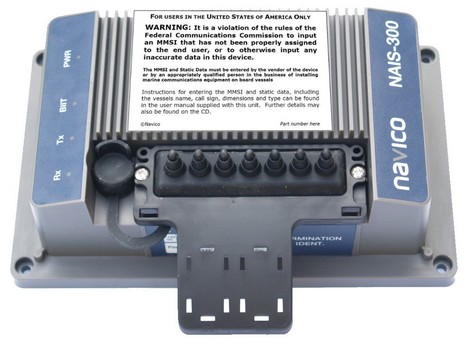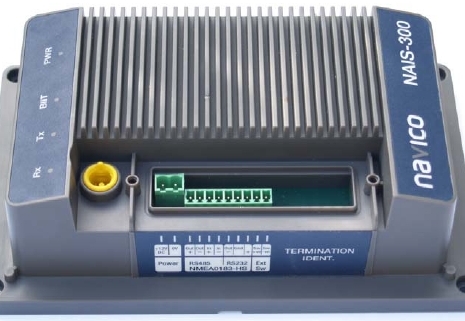Navico NAIS-300 Class B, FCC certified!

Wow, the Class B AIS story is moving fast. If I’m understanding the FCC Equipment Authorization database correctly (select “AIS” from the “Equipment Class” drop-down list), last Friday Navico added one last submission to its NAIS-300 application—the photo above—and the unit was certified that very day, along with the Simrad AI50. The photo, full size here, not only shows a new warning label that’s apparently acceptable to the FCC (remember, it has changed its mind before), but also a Class B transponder I’ve never seen before. So we have two new questions: can an American buy either of these Navico transponders today, and what the heck is a NAIS-300?
Navico/Simrad has not yet answered my query about selling Class B in the USA, but they haven’t had much time! (Heck, everything I know about the NAIS-300 I just found at the FCC.) I’d guess that they are scrambling to understand exactly what that warning label means, as I have been doing in the comments section of Saturday’s entry. One thing that’s clear is that the FCC and USCG mean business… as in a possible $25,000 fine levied against a Class B user with invalid static data, and/or against the vendor/installer who input the invalid data. How is that liability going to be managed? How will the data be validated? Will a document signed by the vessel owner stating MMSI, name, type, and dimensions suffice? And exactly what is a valid Vessel Name anyway? When a manufacturer figures all that out, and gets an FCC certification, then we can buy Class B.
And it looks like the Navico NAIS-300 is going to be an attractive option. It’s a black box Class B transponder that seems to have most every feature of the ACR Nauticast B, or the SevenStar SeaTraceR, or the True Heading B, or variants like Shine Micro’s. But that is indeed a SimNet port you see below, in addittion to the standard RS232 and RS485 outputs able to push NMEA 0183 HS data to plotter and PC. And there’s even an alternate NAIS-300–L model with a standard (instead of SimNet) NMEA 2000 port. I think that’s a big plus; though I’m still not sure if all AIS data can, or ever will, travel over N2K (or SimNet), it could still be very useful for DSC and own position data. There’s lots of info on the NAIS-300 at the FCC and at some European vendors, and more Panbo Class B entries to come.


 Share
Share
Looks like a nice unit. I've been hoping for one in NEMA 2000 rather than 0183. Now what does it cost?
And
With all this new Class B equipment coming out.. has anyone noticed a price reduction in AIS Receivers?